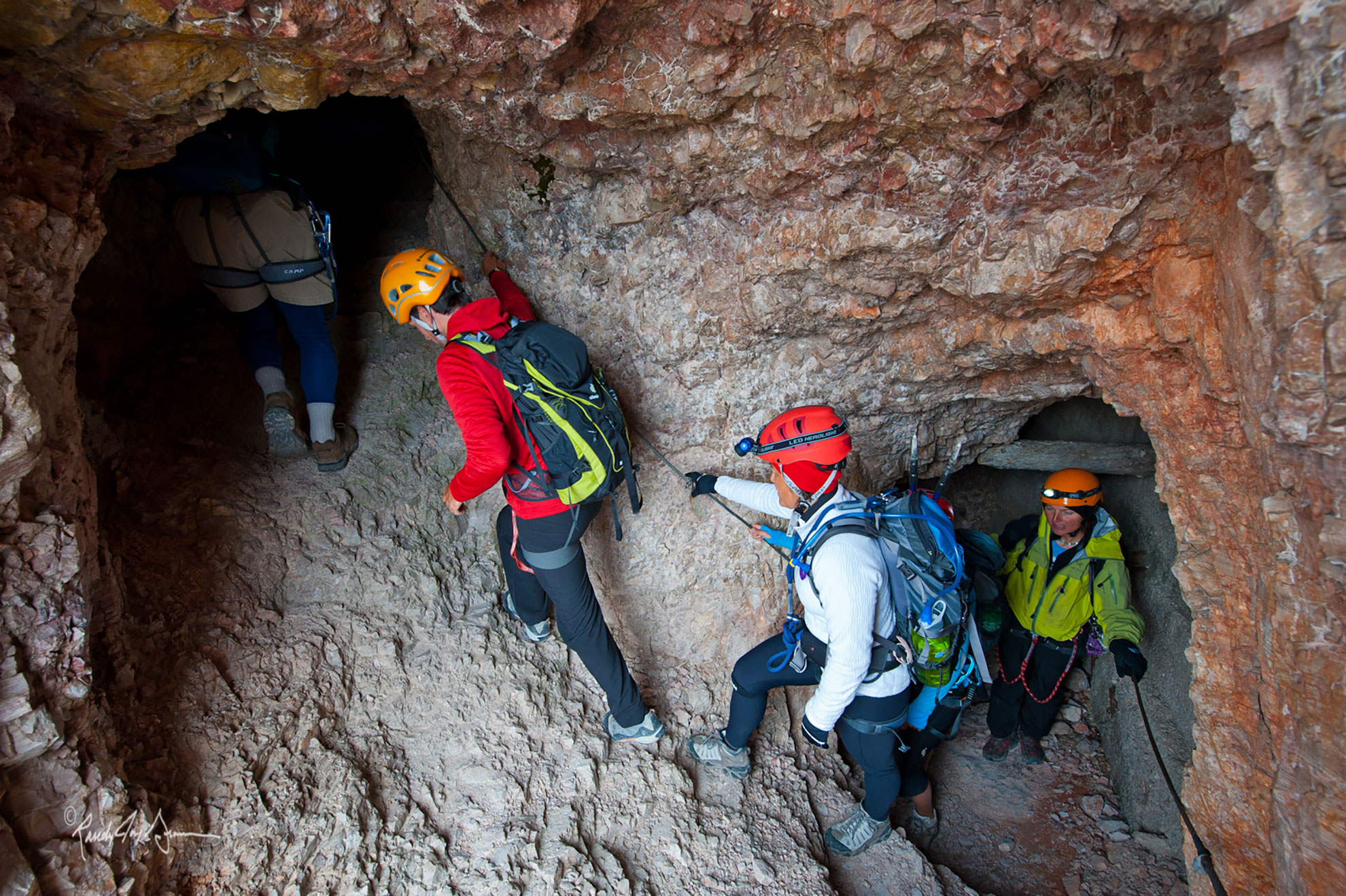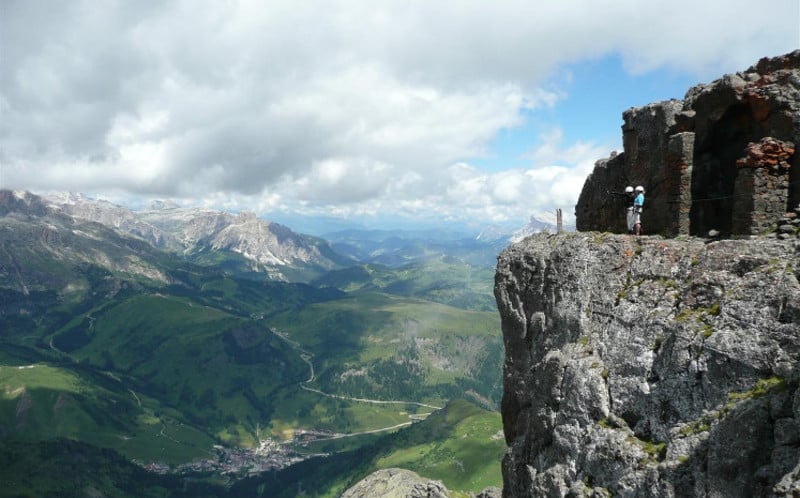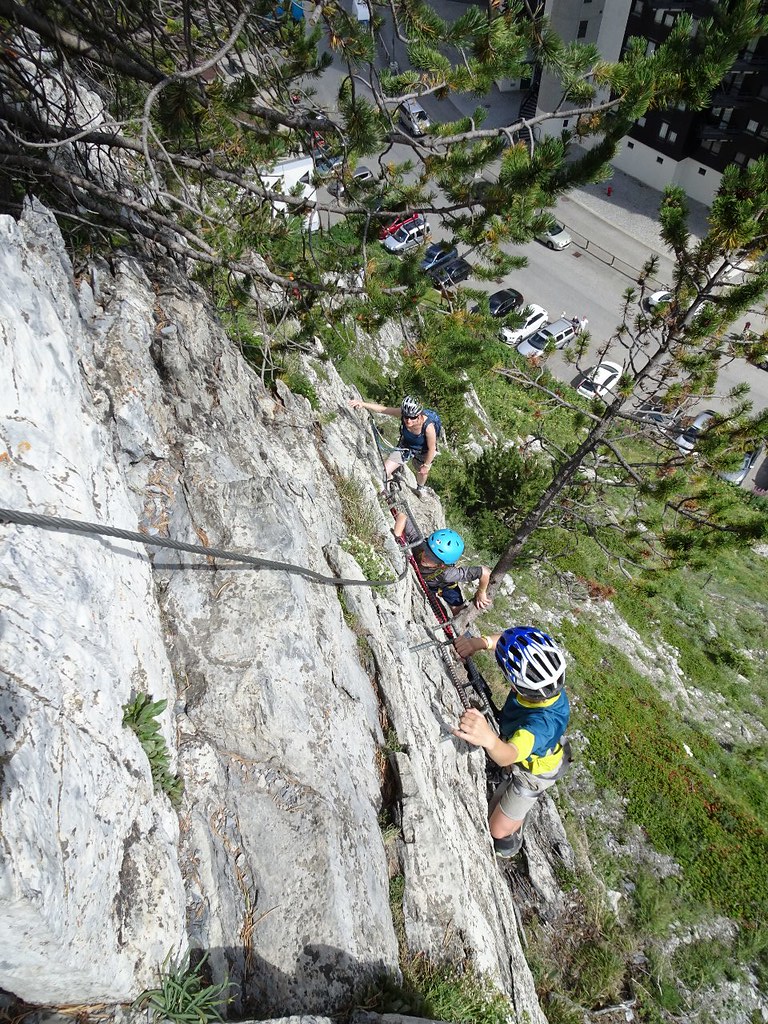- This topic has 29 replies, 16 voices, and was last updated 4 years ago by jimmy.
-
Via Ferrata?
-
athgrayFree MemberPosted 4 years ago
Any via ferrata experts here? Looking for advice. I used to be an avid climber until 10 years ago then stopped. Had a go doing a via ferrata in The Highlands last week. I really loved it and could see myself getting into it.
I was wondering what some of the best routes are around Europe. I am not particularly fit these days, so not looking for long epics at the minute but some hidden gems.
Also what else do I have to consider with via ferrata that are different from climbing?
bowglieFull MemberPosted 4 years agoSounds like you’d love the Dolomites, and I can recommend Val Gardena. Main thing I’d advise with Dolomites is to hook up with a local who’s familiar with the routes – or at least visit the guides station to check condition of routes. An old very experienced friend was well committed on a long route with his son, and got to a section where a rockfall had wiped out the cables and rungs. (& I’ve witnessed an epic rock avalanche over there)
I guess it goes without saying that a helmet is essential attire.
jimmyFull MemberPosted 4 years agoI used to “guide” (loose term) Via Ferrata working for Colletts. If you’re looking for a semi-package holiday check them out – originally based in the Dolomites but they’ve a few locations now, although not sure Via Ferrata availability elsewhere.
There’s a Cicerone guide written by John Smith who was researching it when I was there – did a few trips with him including a long old day to bag a tricky grade. They go from A (an easy scramble) to something like G, which will border on rock climbing in places, but all using the standard VF kit.
footflapsFull MemberPosted 4 years agoThere are two types: Modern Sport and Traditional (WW-1 era stuff).
The sport stuff is normally at low altitude and aimed at making money for local guides, e.g. there is a load near Briancon in France run by the local IFAGM guides (you can just pay and use it on your own).
The older stuff in the Dolomites as a mix of WW-1 troop ladders and ropes and some new fixes to make it a it safer, but it can be very mixed and you really should take a rope and some gear just in case as there are missing sections etc.
There is some better maintained stuff in the Dolomites eg Monte Cristallo (used for final show down in Cliffhanger), which is kept in pretty good nick. Still a long day in the mountains though…
The Circerone guide book to VF in the Dolomites is pretty decent, we used that for a week’s VF there and it was good enough (combined with map and compass etc).
On the Sport stuff, you’ll see loads of people in summer whereas on some of the original stuff you might not see anyone all day and be at altitude, so you need to be mountain savvy…
longdogFree MemberPosted 4 years agoWhat is the via ferrata you did in the Highlands?
I used to climb decades ago, but my joints and fitness are just not up to it (as was proven last week), so I’d thought of scrambling and via ferratas, but I thought they were all on the continent.
jimmyFull MemberPosted 4 years agoOh yeah, the WW1 tunnels at… Forget the name, Passo Campolungo?, is brilliant. Proper history lesson while scrambling about on a mountain.
nukeFull MemberPosted 4 years agoWe did some nice routes in Switzerland at Le Moleson which i can highly recommend.
Would be interested in doing more in the dolomites. One thing I’d like to know is how important is having a via ferrata lanyard with the energy absorber? Do folk just ‘construct’ there own via ferrata with short lengths of rope and karabiners instead or is that just a no-no?
B.A.NanaFree MemberPosted 4 years agoWhilst rock climbing I’ve stumbled on some Briancon stuff, it was somewhere between Briancon and Grenoble.
I’d love to do the original WW1 stuffathgrayFree MemberPosted 4 years agoThe one I did was the one linked by jimmy in Kinlochleven.
I am keen to avoid being guided, but am not desperate to do big epic routes. I thought I could build up to that.
thegeneralistFree MemberPosted 4 years agoAs above, you need to go to the dolomites. The klettersteigs there are utterly brilliant.
Going through the old ww1 tunnels, seeing the ruined wooden huts etc and trying to imagine being there in winter with people trying to shoot you is mind bending. I think the classic ww1 one is near Arabba. I seem to recall seeing it from below while on the Sella Ronda ski circuit.
The Poesnicker is also great.
As regards lanyards. Absolutely get one. If you wouldn’t solo it then don’t do it with a couple of static slings and crabs. The potential fall factors on VF are immense, much bigger than you would ever get rock climbing.
They recently introduced new CE regs for lanyards, to certify them for lighter people as well, so you may find old stock heavily reduced.
You can also hire vf sets in most places. E.g. Val d’ isere.
The Rockfax Dollies guide probably has some Vf in.mrb123Free MemberPosted 4 years agoCorvara in the Dolomites is probably the best base. Loads of classics round there.
The Cicerone guide is more than adequate. Grading is usually pretty accurate.
The sports shop in the town hires out gear but after our first trip we bought our own.
chickenmanFull MemberPosted 4 years agoFrance is brilliant for this. Lots of villages in the S of France have had VFs installed to attract in outdoor type visitors. With your own kit there is no need for a guide and often no charge to use them. Junior & I particularly enjoyed Lantosque in the Alpes Maritine, Saint Hilaire in the Chartreuse (Grenoble) on which there was a 200ft overhanging headwall which was about E2 or F6b to climb without clipped in rests.
Get hold of a rope pulley for those long aerial runways that often feature.thegeneralistFree MemberPosted 4 years agoHablo Deutch?
As with may things, the Germans lead the way with guides etc to the Dolomites. SO if you speak German then the following printed guide will help:
https://www.bergsteigen.com/shop/produkt/neu-klettersteigfuehrer-dolomiten-suedtirol-gardasee-mit-touren-app-4te-auflage/There are loads of online guides here too:
eg the Poessnecker (sp) as I mentioned above:
https://www.bergsteigen.com/touren/klettersteig/poessnecker-klettersteig/The Piscadu is also good.
I think the classic WW1 one is this one:
https://www.bergsteigen.com/touren/klettersteig/trincee-klettersteig/
which does indeed start above the Sela Ronda pistes, though I think you access it from the south (Marmolada lake) side in summerTunnels:
some good waffling on here about VFs:
ampthillFull MemberPosted 4 years agoI’d say the Dolomites rockfax guide was brilliant in every way.
I think an ex climber with the correct kit and that book will be fine. Grade 3 felt like diff climbing but slightly less well protected than leading. So yes the lanyard is vital. If you fell 2 metres from a stantion you would fall 3 metres then stop fast enough to brake you and the stantion, without the energy absorber. On the routes we did stantions were put by harder moves.
My son and I were both climbers that year. Me leading 5+ and my son 6a. So the via fer’ was easy to use but great fun. We met loads of families who clearly weren’t use to climbimy
Enjoy
EwanFree MemberPosted 4 years agoI’ve done loads all over france and italy – we love them. Dolomites is nice – the circone guide and the rockfax guide are both good.
Personally tho i prefer the Briancon area – lots of nice challenging ones round there – most locations have a few difficulty options. There is a free app for the area – search for Via Ferrata on googleplay – it’s the one called “Ecrins & Briancon via ferrata”.
Obviously don’t try and use a couple of slings – fall factors involved will kill you. And wear a helmet especially on proper mountain ones (stuff falls off mountains!). If you have not done much before, don’t be lured into a false sense of protection by the lanyards – they’re death prevention rather than injury prevention. There are plenty of sections on modern and old via ferratas where a fall will mean serious injury – people always ask what happens if your lanyard deploys half way round a route – the answer is that if your lanyard has deployed, you probably need a helicopter anyway!
EwanFree MemberPosted 4 years ago(Don’t read the above as trying to put you off – they’re great!)
Forgot to say, that generally if you google any french town name in the south or mountainous bits of france you’ll generally find that the town has a local via ferrata. I’ve got a massive french guide to them with hundreds in it, and I still find extra ones by googling!
footflapsFull MemberPosted 4 years agoThey recently introduced new CE regs for lanyards, to certify them for lighter people as well, so you may find old stock heavily reduced.
I’ve still got a load of the old style knuckle duster arrestors, you had to feed the rope through them multiple times, like very loose shoe laces and the friction pulling it all tight would hopefully stop the rope snapping / your hips fracturing in two….
All a lot more modern / safer / simpler now…
NB and don’t forget prussock loops, if you do fall and end up hanging 6′ below the wire, you need to be able to climb back up again, assuming your pelvis is still intact….
littlerobFull MemberPosted 4 years agoI’d echo a lot of what others have said: The Dolomites are ace, Corvara is a great base (good cycling too!), and Colletts are a very good company. However, its not essential to go that far. We’ve done one in the Jura https://www.viaferrata-fr.net/via-ferrata-172-Le-regardoir–Lac-de-Vouglans-Moirans-en-Montagne-Jura.html and several in the Alps (e.g. https://www.viaferrata-fr.net/via-ferrata-140-Curalla-Passy-Haute-Savoie.html)
As others have said, you need a proper VF sling (i.e. Don’t use a rope). And the rules are pretty much: Don’t fall.
Also, be careful in the afternoon if there is a threat of thunder.
LR
PS If you do go to Corvara, rent road bikes from Sport Kostner and do the Sella Ronda. Its epic.EdukatorFree MemberPosted 4 years agoFalling is highly unlikely. If you don’t let go of the steering wheel when driving or the handlebars and pedals doing downhill then you won’t just fall off. You might get tired/pumped though which happens slowly and gives you plenty of warning. In addition to the usual pair of shock-absorber cows’tails I suggest a longish quick draw on your harness tie-in to clip on to a rung for a rest.
Grippy gloves are a good idea on long routes.
footflapsFull MemberPosted 4 years agoGrippy gloves are a good idea on long routes.
I would say decent leather gloves are essential on the WW1 stuff, 100 year old rusty wires with sharp bits sticking out. Black Diamond do some good ones which are fingerless and designed for VF / ropework.
EwanFree MemberPosted 4 years agoDecathlon do a good via ferrata kit for not too much dosh, they also do fingerless gloves (like the black diamond ones above, but cheaper – I’ve got both, but I use the decathlon ones…). Gloves are certainly essential – often pointy cables – you want fingerless gloves. I do like to spend money on climbing gear, but with the decathlon set, i’ve never felt the need – which is probably a recommendation.
Two prussock loops is a good call – you never know, you might not have a broken leg if it deploys! As someone said above it’s pretty hard to fall off, unless you’re being an idiot.
rsl1Free MemberPosted 4 years agoAny recommendations for routes/guides around Lake Como or Maggiore? Doing a roadtrip down there in August with a group that loves a good adventure. About 10 people all good fitness but some with limited climbing experience so I guess a guide is a must? (For reference we climbed Pedraforca the scrambley way and that was on the edge of comfort for some of the group last summer)
thegeneralistFree MemberPosted 4 years agoooh found photos of the one near Tignes:
This was the point we bailed, much to his relief
EdukatorFree MemberPosted 4 years agoThere’s definitely a problem with clipping in that first pic (it looks like the first climber has climbed past an anchor without moving the crabs up and the second climber is sorting it out) and the last one looks like one of the most dangerous places on any via, the place with a high death rate: the point you unclip and walk along the muddy slippy return path.
thegeneralistFree MemberPosted 4 years agoand the last one looks like one of the most dangerous places on any via, the place with a high death rate: the point you unclip and walk along the muddy slippy return path.
Nah. He’s still well and truly clipped in. He just looks worried as he’s spotted Where it goes along that slightly overhanging wall in the left background with a handrail and footrail that are just too far apart for his tiny frame to accommodate.
Hard to see, but just to the left of the rickety bridge…..
B.A.NanaFree MemberPosted 4 years agoI would say decent leather gloves are essential on the WW1 stuff,
Good point, but I’d personally go to B&Q and buy gardening gloves for £1.99 or whatever, leather or rubber palmed (in case you get struck by lightening. 🙂 ) I don’t bother with silly expensive branded over designed ‘mountaineering’ jobs from outdoor shops (cut the fingers off if you wish). I agree tho Don’t use anything else of light weave material they’ll be shredded in a few days.
jimmyFull MemberPosted 4 years agoAlso, be careful in the afternoon if there is a threat of thunder.
Oh yeah, the time I got a group stranded at the top of a mountain in a cave when thunder struck 💩 💩 💩
The topic ‘Via Ferrata?’ is closed to new replies.





